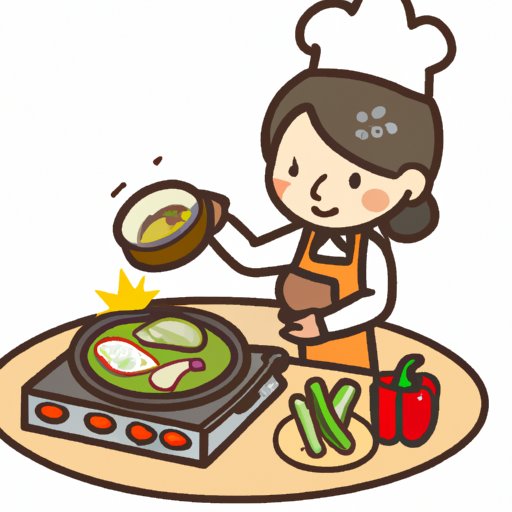I. Introduction
Cooking chicken breast is often considered one of the easiest dishes to prepare as it is nutritious, affordable, and delicious. However, it can be challenging to cook it on the stove without overcooking it or ending up with a dry and flavorless piece of meat.
In this article, we will provide a beginner’s guide to cooking chicken breast on the stove using the classic method, where we will go over everything you need to know to get a perfectly cooked and juicy piece of chicken every time.
II. Essential Tools and Ingredients
To cook chicken breast on the stove, you will need a few essential tools and ingredients:
- Large skillet or frying pan
- Tongs or a spatula
- Meat thermometer
- Boneless, skinless chicken breast
- Salt and pepper
- Oil for cooking (olive oil, vegetable oil, or any other oil with a high smoking point)
When cooking chicken breast, it’s crucial to use quality ingredients, including fresh chicken. Look for chicken labeled “air-chilled” if possible, as it’s more flavorful and juicy than those that are water-chilled.
III. Preparation
Before cooking chicken breast, it’s important to follow a few preparation steps :
- Thaw the chicken breast: If using frozen chicken breast, thaw it in the refrigerator overnight or for at least 4-6 hours before cooking. Never thaw chicken breast on the counter as it can quickly grow harmful bacteria.
- Season the chicken breast: Pat the chicken breast dry with a paper towel, then season both sides with salt and pepper. You can also optionally marinate the chicken breast in your preferred marinade for at least 30 minutes or up to 12 hours before cooking.
IV. Cooking Process
Now it’s time to start cooking the chicken breast using the classic method:
- Heat the skillet: Heat a large skillet over medium-high heat and add oil, enough to cover the bottom of the pan.
- Add the chicken breast: Once the oil is hot and shimmering, add the chicken breast to the skillet. Cook for 6-7 minutes on each side, depending on the thickness of the chicken breast, until golden brown and crispy on the outside.
- Monitor the heat: While cooking the chicken breast, it’s essential to monitor the heat. If the chicken breast starts to brown too quickly, reduce the heat to avoid burning the outside while the inside remains undercooked.
- Check the temperature: Use a meat thermometer to check the internal temperature of the chicken breast to ensure it’s cooked to a safe temperature of 165°F (74°C). Insert the thermometer into the thickest part of the chicken breast, making sure not to touch the bone.
- Let it rest: Once the chicken breast reaches the right temperature, remove it from the pan and let it rest for 5-10 minutes before slicing or serving. This allows the juices to redistribute and the chicken breast to remain tender and moist.
When cooking chicken breast on the stove, it’s essential to get a good sear on the meat to keep it from getting dry. High heat is crucial to develop a crisp outer crust, but it’s also important to not overcook the chicken breast to keep it juicy.
V. Checking Doneness
When cooking chicken breast, it’s crucial to check its doneness to ensure it’s thoroughly cooked. The easiest and most accurate way to do this is by using a meat thermometer.
Insert the thermometer into the thickest part of the chicken breast, making sure not to touch the bone. Once it reaches an internal temperature of 165°F (74°C), it’s ready to eat.
VI. Resting and Serving
After cooking, it’s essential to let the chicken breast rest for a few minutes before slicing or serving. This is because when meat is heated, the juices move toward the center, so resting the chicken allows the juices to redistribute throughout the meat, making it moist and tender.
Once the chicken breast has rested, slice it at an angle against the grain to make it more tender and easier to chew. It’s now ready to be served with your favorite sides and sauces.
VII. Troubleshooting
If you encounter any issues when cooking chicken breast on the stove, here are some common problems and solutions:
- The chicken breast is too dry: Make sure not to overcook the chicken breast, and let it rest before cutting it to keep it moist.
- The chicken breast is not crispy enough: Increase the heat and cook it for an extra 1-2 minutes on each side.
- The chicken breast is sticking to the pan: Ensure the pan is well-oiled, and do not move the chicken breast around the pan until it’s well-seared.
VIII. Conclusion
By now, you should feel confident in cooking chicken breast on the stove using the classic method. Remember to use quality ingredients, monitor the heat, check the doneness, and let the chicken breast rest before serving.
With these tips and tricks, you can easily prepare a delicious and nutritious chicken breast that’s perfect for any occasion.
